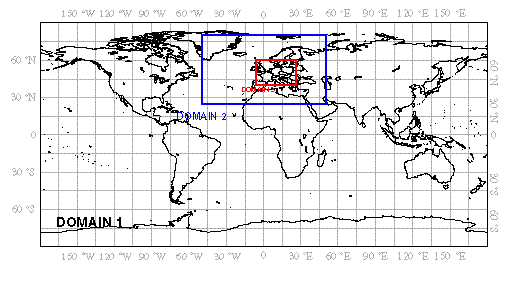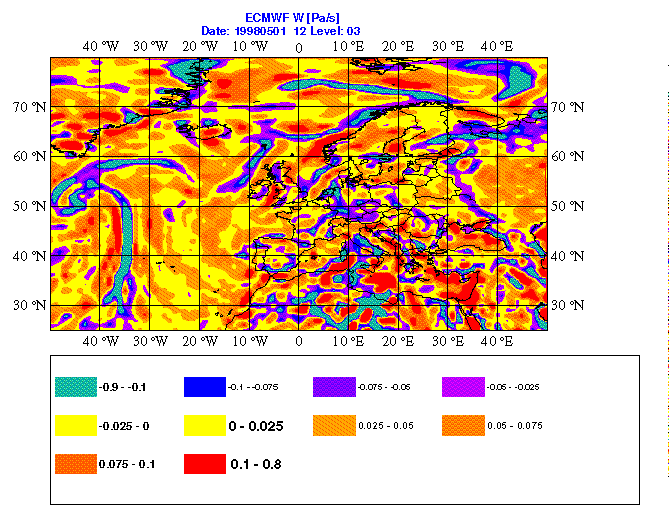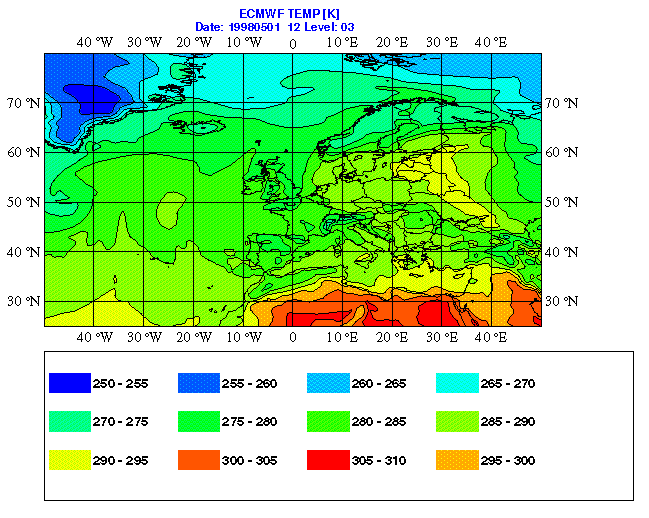| IMP | Institute
of Meteorology and Physics
University of Agricultural Sciences, Vienna, Austria |
 |
| Environmental Meteorology Group |
| IMP | Institute
of Meteorology and Physics
University of Agricultural Sciences, Vienna, Austria |
 |
| Environmental Meteorology Group |
|
The version presented here is obsolete. It has been superseded by a new version prepared by Paul James in Munich. Get this new version here. Petra Seibert, 31 Jan 2001 |
Warning: In order to use these routines, it is necessary to have a user account on ecgate1.ecmwf.int
For more information: send email
to Gerhard Wotawa
fluxjobs/ (Retrieval/de-accumulation of flux data) fluxjobs/job.flux fluxjobs/caldate.f fluxjobs/commonvar fluxjobs/deaccumulate.f fluxjobs/fluxinterpol.f fluxjobs/juldate.f fluxjobs/parameter fluxjobs/readflux.f fluxjobs/surfjob.new fluxjobs/writeout.f job.tra/ (Retrieval of met. fields, calculation of d(eta)/dt job.tra/caldate.f job.tra/create_job.f job.tra/execute_job.f job.tra/extract.f job.tra/juldate.f job.tra/makeinclude.f job.tra/CONTROL job.tra/includepar
The following flux data needed by FLEXPART are retrieved on a user-selectable geographical grid (lamda-phi):
| Abreviation | Full name | Unit | Field code |
| LSP | Large Scale Precipitation | mm/hr | 142 |
| CP | Convective Precipitation | mm/hr | 143 |
| SSHF | Surf. Sens. Heat Flux | W/m2 | 146 |
| EWSS | East-West Surf. Stress | N/m2 | 180 |
| NSSS | North-South Surf. Stress | N/m2 | 181 |
| SSR | Surf. Solar Radiation | W/m2 | 176 |
Flux data are not available in the ECMWF analyses, but they can be obtained (in accumulated form) from the ECMWF short-term forecasts (first guess) stored in three-hourly intervals (see ECMWF MARS database manual).
For de-accumulation, the following strategy is followed:
This step has been fully automated. The user just has to fill in a CONTROL file, providing information like beginning date, ending date, time interval, number of levels to extract, ecfile directory for (optional) flux data input, ecfile directory for output. Afterwards, the execution of a.out creates a batch script and sends it to batch queue ecgate1.normal.
The batch file is saved under /tmp/job.prepo.bak.uid. After execution, a job log file in ~uid/waitqueue named METEprepXXXXXX with XXXXXX being a system-generated, unique number, is created. Beginning and end of execution are anounced to the user via e-mail.
The batch-job works as follows:
Technical comments:
| Abreviation | Field code | Name |
| SDOR | 160 | Std. Deviaton of Orography |
| VEG | 199 | Percentage of vegetation |
| SR | 173 | Surface roughness |
| LCC | 186 | Low cloud cover |
| MCC | 187 | Medium cloud cover |
| HCC | 188 | High cloud cover |
| SKT | 235 | Skin temperature |
| STL1 | 139 | Soil temperature level 1 |
| SWL1 | 140 | Soil wetness level 1 |
Please notice: The new routines just work for ECMWF data from 04/04/1995 0 UTC onwards. If you want to extract older ECMWF data, use the previous version of job.tra.
If you want to use these routines, just download them. (NEW: 12.1.1999 -> Bug reports!!!)
The file ecmwf2.tar has the following structure:
job.tra1995+/CONTROL job.tra1995+/CONTROL_0.5 job.tra1995+/CONTROL_1.0 job.tra1995+/CONTROL_2.0 job.tra1995+/caldate.f job.tra1995+/create_job.f job.tra1995+/execute_job.f job.tra1995+/extract.f job.tra1995+/juldate.f job.tra1995+/makeinclude.f fluxjobs_0.5/caldate.f fluxjobs_0.5/deaccumulate.f fluxjobs_0.5/fluxinterpol.f fluxjobs_0.5/juldate.f fluxjobs_0.5/readflux.f fluxjobs_0.5/writeout.f fluxjobs_0.5/parameter fluxjobs_0.5/commonvar fluxjobs_0.5/surfjob.new fluxjobs_0.5/job.flux fluxjobs_1.0/caldate.f fluxjobs_1.0/deaccumulate.f fluxjobs_1.0/fluxinterpol.f fluxjobs_1.0/juldate.f fluxjobs_1.0/readflux.f fluxjobs_1.0/writeout.f fluxjobs_1.0/parameter fluxjobs_1.0/commonvar fluxjobs_1.0/surfjob.new fluxjobs_1.0/job.flux fluxjobs_2.0/caldate.f fluxjobs_2.0/deaccumulate.f fluxjobs_2.0/fluxinterpol.f fluxjobs_2.0/juldate.f fluxjobs_2.0/readflux.f fluxjobs_2.0/writeout.f fluxjobs_2.0/parameter fluxjobs_2.0/commonvar fluxjobs_2.0/surfjob.new fluxjobs_2.0/job.fluxThree different domains have been prepared for the retrieval of meteorological data:

North Pole:
where lambda are the geographical longitude (-pi to + pi), ff the
wind speed at the pole, dd the wind direction at the pole. Both, ff and
dd, are constant for the Pole.
The wind direction is calculated as follows:
For example: A wind direction of pi (180 DEG) means that the wind
at the pole blows along the Greenwich meridian towards the pole. If the
wind direction is 0, the wind blows the other way round.
South Pole:
The wind direction is calculated as follows:
For a better understandig, I provide a little program where wind
at the south and north pole is transformed to speed and direction and subsequently
transformed back according to the pole convention used by ECMWF:
* SOUTH POLE DO 666 I=1,NX LLON=-178+FLOAT(I-1)*DX LLON1=LLON*PI/180. WSPEED=SQRT((U3D(I,1,1)**2)+(V3D(I,1,1)**2)) IF(V3D(I,1,1).lt.0.) THEN DDPOL=ATAN(U3D(I,1,1)/V3D(I,1,1))+LLON1 ELSE DDPOL=PI+ATAN(U3D(I,1,1)/V3D(I,1,1))+LLON1 ENDIF IF(DDPOL.LT.0.) DDPOL=2.0*pi+DDPOL IF(DDPOL.GT.2.0*PI) DDPOL=DDPOL-2.0*pi UNEW=+WSPEED*SIN(LLON1-DDPOL) VNEW=-WSPEED*COS(LLON1-DDPOL) 666 WRITE(999,778) I,LLON,U3D(I,1,1),V3D(I,1,1),WSPEED, & UNEW,VNEW *NORTH POLE DO 777 I=1,NX LLON=-178+FLOAT(I-1)*DX LLON1=LLON*PI/180. WSPEED=SQRT((U3D(I,NY,1)**2)+(V3D(I,NY,1)**2)) IF(V3D(I,NY,1).lt.0.) THEN DDPOL=ATAN(U3D(I,NY,1)/V3D(I,NY,1))-LLON1 ELSE DDPOL=PI+ATAN(U3D(I,NY,1)/V3D(I,NY,1))-LLON1 ENDIF IF(DDPOL.LT.0.) DDPOL=2.0*pi+DDPOL IF(DDPOL.GT.2.0*PI) DDPOL=DDPOL-2.0*pi UNEW=-WSPEED*SIN(LLON1+DDPOL) VNEW=-WSPEED*COS(LLON1+DDPOL) 777 WRITE(999,778) I,LLON,U3D(I,NY,1),V3D(I,NY,1),WSPEED, & UNEW,VNEW 778 FORMAT(i3,1x,f5.0,1x,5f7.2)Important remark: A spectral truncation of T106 is default in the ECMWF mars system for the retrieval of 2x2 DEG lambda-phi data out of the Sperical Harmonics (SH) data. However, as I have tested, this truncation is insufficient to obtain accurate wind data at the poles. If you use the latest (6.1.1999) version of my routines, this problem is fixed. If not, make sure that U,V wind components are retrieved at least with T213 or T319. This problem is serious. Wind data at the poles are definitely unusable with the lower truncation.
You are kindly invited to report problems and bugs to
me.
#QSUB -r SURFdata #QSUB -s /bin/ksh #QSUB -eo #QSUB -lM 200Mb #QSUB -lm 200Mb #QSUB -lT 400 #QSUB -lt 400 #QSUB -mb #QSUB -me #QSUB cd $TMPDIR PATH=$PATH:. DAY=19970526/to/19970528 HOUR1=00/06/12/18 HOUR2=03/09/15/21 AREALF=80.0/-50.0/25.0/50.0 GRIDLF=1./1. export PATH export DAY export HOUR1 export HOUR2 export AREALF export GRIDLF cd $SCRATCH cat >zrequest<<EOF RETRIEVE, TYPE=FG, PARAM=LSP/CP/SSHF/EWSS/NSSS/SSR, AREA=$AREALF, GRID=$GRIDLF, LEVTYPE=SFC, LEVELIST=OFF, REPRES=GG, DATE=$DAY, TIME=$HOUR1, AC=N, STEP=06, TARGET="surf_06_ub" END EOF mars zrequest cat >zrequest<<EOF RETRIEVE, TYPE=FG, PARAM=LSP/CP/SSHF/EWSS/NSSS/SSR, AREA=$AREALF, GRID=$GRIDLF, LEVTYPE=SFC, LEVELIST=OFF, REPRES=GG, DATE=$DAY, TIME=$HOUR2, AC=N, STEP=03, TARGET="surf_03_ub" END EOF mars zrequest ecp -o surf_* ec:/vo3/metdat/
#! /bin/ksh #COPY INPUT OF FLUXACC TO /tmp ecp -o ec:/vo3/metdat/surf_* /tmp/ #EXECUTE FLUXACC FLUXACC #SAVE OUTPUT OF FLUXACC IN ECFILE DIRECTORY ecp /tmp/flux* ec:/vo3/flux/ #DELETE INPUT OF FLUXACC erm ec:/vo3/metdat/surf_* #CLEAN UP rm /tmp/surf_* rm /tmp/flux*
1995031415 1995031415 3 1.0 -50.0 50.0 25.0 80.0 28 29 31 319 ka7 /ws/home/ms/at/ka7/job.tra/ ec:/ka7/flux/ ec:/ka7/metdat/ * CONTROL FILE * * 1. BEGINNING DATE [yyyymmddhh] * 2. ENDING DATE [yyyymmddhh] * 3. TIME INTERVAL [hr] * 4. GRID RESOLUTION [DEG] * 5. GRID DOMAIN - LLON/RLON/BLAT/TLAT * 6. VERTICAL LAYERS TO EXTRACT (UVTQ and W) * 7. NUMBER OF LAYERS AVAILABLE FROM ECMWF * 8. SPECTRAL TRUNCATION NEEDED (<= TRUNCATION ARCHIVED) * 9. USER NAME * 10. DIRECTORY WHERE JOB.TRA IS INSTALLED * 11. DIRECTORY WHERE DEACCUMULATED FLUX DATA ARE AVAILABLE * (EC FILE SYSTEM) * 12. DIRECTORY WHERE ENYYMMDD OUTPUT FILES ARE SAVED * (EC FILE SYSTEM) ********************************************************** DOMAIN: TLAT + + + + + + + + + RLON + + + + + + + + + + + + + + + + + + + + + + + + + + + LLON BLAT ***************************************************** SPECTRAL TRUNCATION/LAYERS AVAILABLE FROM ECMWF MODEL T63 L16 Beginning: 20/04/1983 1800 T106 L16 Beginning: 01/05/1985 0000 T106 L19 Beginning: 03/04/1987 0000 T213 L31 Beginning: 17/09/1991 0000 T319 L31 Beginning: 01/04/1998 0000 T639 future ********************************************** DEPENDENCE OF TRUNCATION TO NEEDED LAM-PHI OUTPUT Gaussian Lat/long grid increment truncation ---- -------------------------------- ---- N36 2.5 and greater T63 N60 1.5 up to, but not including 2.5 T106 N150 0.6 up to, but not including 1.5 T213 N225 0.4 up to, but not including 0.6 T319 N225 Up to, but not including 0.4 T639



 Last update: 12 Jan 1999 by Gerhard
Wotawa | URL of this page: http://www.boku.ac.at/imp/envmet/ecmwf_extr.html
Last update: 12 Jan 1999 by Gerhard
Wotawa | URL of this page: http://www.boku.ac.at/imp/envmet/ecmwf_extr.html